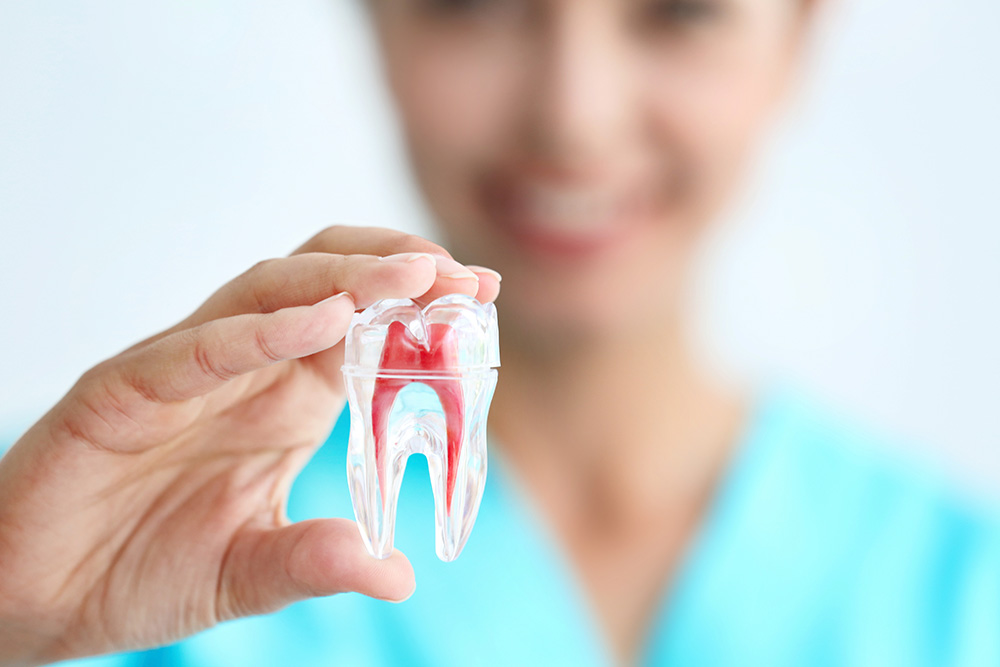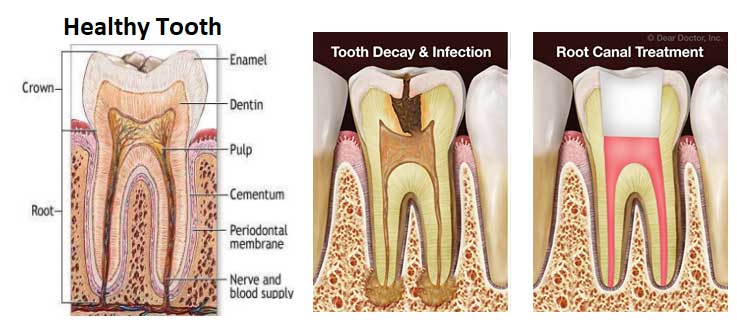Endodontics – Root Canal Treatment



Root Canal Treatment / Endodontic Therapy
Inside the tooth, under the hard, white enamel and the yellowish layer of dentine, is a soft tissue called the pulp. The pulp contains blood vessels and nerves which make the tooth a living structure. It extends from the crown which is the part of the tooth that is visible inside the mouth, to the tip of the roots which is the part hidden under the gums. The pulp is important during a tooth’s growth and development.
What is a root canal treatment?
Root canal therapy is the complete removal of the dental pulp followed by thorough cleaning, shaping and filling of the root canal system so the tooth can remain as a functional unit within the dental arch.
When is a root treatment necessary?
Endodontic therapy treats the inside of the tooth. It is required when the pulp becomes inflamed or infected. The most common cause of infection is dental caries where deep decay reaches the pulp. Another common cause is trauma which leads to a crack or a fracture in the tooth. In addition, an injury to a tooth may cause pulp damage even if there are no visible signs of trauma. Inflammation can also be due to periodontal causes that lead to loss of vitality of the tooth.
If pulp inflammation or infection is left untreated, it can cause pain or lead to an abscess and spread of bacteria. Root canal treatment is carried out to;
- Relief of pain
- Eradication of infection
- Obturation (filling) of the root canal system to prevent re-infection
What are the symptoms leading to endodontic therapy?
Possible signs include;
- Pain which can vary in intensity, spontaneity and continuity.
- Tenderness to touch or chewing
- Persistent sensitivity to heat or cold
- Discolouration of the tooth
- Swelling in the gums or face
- Sometimes, there are no symptoms.
It is important to note that this pain can spread to different areas on the same side of the face including the opposing jaw.
The pain might wake you up at night.
The tooth in question might even become loose from its’ socket, which means it does not remain fixed to its original position.
The appearance of a tooth requiring root canal treatment varies, but may include some of the examples shown.
Diagnosis of a necrotic tooth will require several tests including;
- Detailed History of the patient
- History of the pain and current symptoms
- Localisation of the pain with percussion and palpation tests
- Dental pulpal testingis a clinical and diagnostic aid used in dentistry to help establish the health of the dental pulp within the pulp chamber and root canals of a tooth. Such investigations are important in aiding dentists in devising a treatment plan for the tooth being tested. There are two major types of dental pulp tests. “Vitality testing” assesses the blood supply to the tooth, whilst “sensitivity testing” tests the sensory supply.
- Radiographic Examination (x-rays)
The last part of a root canal treatment entails filling the tooth. A restored tooth after root canal therapy could last a lifetime with regular check-ups and maintenance of a good oral hygiene. Further protection of the tooth might require the placement of a ceramic crown. This very often prevents breakages (fractures) of the posterior teeth and improves the aesthetics of anterior ones.

Clinic Opening Hours
- Monday - Friday 08:00AM - 07:00PM
- Saturday 08:00AM - 04:00PM
- Sunday / Holidays Closed

